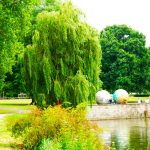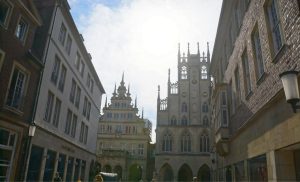The weather is rather gloomy when the SOLAARIS stops at the shore of the Aasee and we leave the ship to visit the open-air museum Mühlenhof Münster. But we were lucky and during our stay the sun appeared from time to time – ideal conditions to explore the grounds.
The area of the museum is about 5 hectares and you can see about 30 large and small buildings from the 16th – 19th centuries. The buildings are almost all original buildings, which were dismantled in their original location in Münsterland and Emsland and rebuilt in the open-air museum. Some of the buildings have been faithfully reconstructed. The interior furnishings and work tools have also been integrated into the museum as appropriately as possible. Thus, a small village has been created, in which one can easily learn about life in the past.

Tour of the Mühlenhof Münster
Through the gatehouse you enter the museum premises. The reconstructed house from the 18th century is comparable to the courtyard entrance of a large farmstead, which was surrounded by protective moats. In the past, visitors also parked their horses in the gatehouse.

On a large square stands a large half-timbered building. The Gräftenhof from 1720 originally stood in the Schonbeck farming community. Around 1805, the owners added a side extension to the large Low German hall house, the so-called salon. I found the landscaped farm garden behind the house particularly beautiful. Flowers were blooming here and bees were buzzing around everywhere. Dreamlike beautiful! The small garden was also laid out according to historical models and designed as an ornamental and kitchen garden.

A little further on we pass the large Bockwindmühle. This comes from the Emsland and is from 1748. Until the middle of the 20th century, the mill was still in operation.
In former times it was common that the mill stood on a small often artificially created hill, the Mühlenknapp. There the trestle was erected, a basic construction of stone bases and wooden sleepers, on which the mill was built. This is where the name “Bockwindmühle” comes from. The mill could be aligned according to the wind direction and, depending on the grinder, could grind up to 50 hundredweight of grain per day. Unfortunately, it was not possible to visit the mill from the inside. I always find it very exciting when the original construction can still be seen inside.

The bakehouse in the open-air museum Münster could also be visited from the inside. The house from 1749 comes from the district of Warendorf. You can see the brick oven inside, in addition to old equipment that was needed for baking.
In some places there were additionally baking huts, which stood a little bit apart, in order not to endanger the whole village in case of a possible fire outbreak. Such a hut with an oven made of field-fired bricks can also be seen here.


In the open-air museum Mühlenhof Münster is also built the building of a country school, which originated in the district of Steinfurt. The building, built in 1823, was once the classroom for 130 children. We went into the building and looked at the classroom, where several grades were always taught by one teacher at a time. In the middle of the room there was a stove, which ensured that it was pleasantly warm in winter. There were also texts in old German script in the room. I thought it was great that a group of seniors, who entered the room shortly after us, enthusiastically shared their knowledge of the script and deciphered the text together. I would have had no idea what many of the letters meant.

During our tour through the open-air museum you can discover a lot. From the carriage house, the half-timbered chapel, the shoemaker’s house to the carpenter’s workshop – everywhere you could learn something about village life from the 16th-19th centuries. Numerous small exhibitions, like for example in the weaver’s house the exhibition about “Female handicrafts 1850-1930” or the farm workshop show diversified something about the handicraft at that time.
We liked it
We spent quite a long time in the grounds of the open-air museum and really enjoyed the time. Not only did we learn and discover a lot, it was also wonderfully quiet and relaxing here. Only a few visitors strolled through the facility and often you could discover the buildings all by yourself.

Address:
Theo-Breider-Weg 1
48149 Münster
There are numerous free parking spaces.
Opening hours:
April-October
Monday – Sunday: 10 am – 6 pm
Novembre-March
Tuesday-Sunday: 10 am – 5 pm
closed: Monday 24.12., 31.12., 1.1. and in case of extreme weather conditions
Admission fees:
Adults: 6,-€
Discounts are offered.

Disclosure: The visit to the open-air museum Mühlenhof Münster was made possible for us free of charge through the use of the sponsored münstercard.The report corresponds to our experience.














Leave a Reply